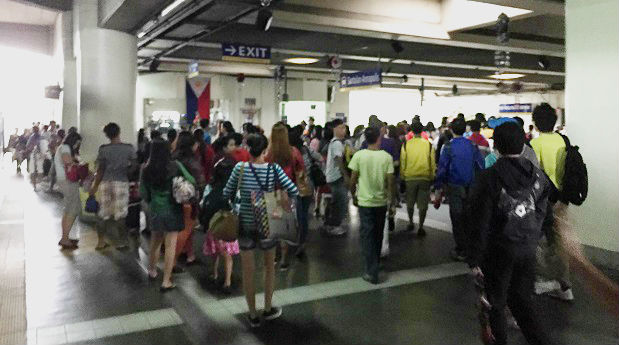
Irked commuters could not do anything but leave the Santolan station after an MRT train stalled as it approached the Ortigas station due to damaged tracks. ARIES JOSEPH HEGINA/INQUIRER.net
Higher fares at Metro Manila’s elevated train lines will go into effect on Sunday.
The long-delayed but unpopular measure, aimed at reducing the burden on the government of billions of pesos in annual subsidies, will be implemented as announced, despite threats by militant groups to run to the Supreme Court to stop the increase.
The fare hike, which was approved as early as 2011, will take the form of an P11 plus P1 formula. This means a base fare of P11 plus P1 for every kilometer traveled for the Light Rail Transit Line 1 and Line 2 and the Metro Rail Transit Line 3, which serve a combined one million passengers each day.
In the case of MRT-3, the maximum fare a passenger will pay for the full 17-kilometer stretch from the North Ave. station to the Taft Ave. station is P28, or about double the current cap. Maximum LRT-1 fares will hit P30 for a single journey. The maximum fare for the newer LRT-2 is P25.
According to the Department of Transportation and Communications (DOTC), the increase for the “average passenger for the average trip” was pegged at P6.
The DOTC defended the increase, saying that it was long overdue, was still cheaper than the buses plying the same route, and would help channel savings to infrastructure projects and other government services outside Metro Manila.
The government has been posting copies of the new fare matrix on the MRT and LRT stations, with some passengers sharing them via social media websites.
DOTC spokesperson Michael Sagcal confirmed yesterday the fare hike would push through today.
The increase, despite public consultation in 2011 and in 2013, is nevertheless unpopular and has been delayed several times. In the case of MRT-3, it has angered commuters who have had to put up with the system’s glitches, long queues and packed cars.
The Bagong Alyansang Makabayan (Bayan) and other groups said they were ready to challenge the hike before the Supreme court on Monday, claiming that the Aquino administration had no jurisdiction to increase rates.
Some of the questions will look into the peculiar way elevated railway rates are increased, including the fact that the DOTC and the Light Rail Transit Authority are the proponents, approving bodies and implementors of the fare hike, said Bayan secretary general Renato Reyes Jr. in a text message.
“We call on the riding public to protest the increase and support the Supreme Court petition we will be filing on Monday. Let’s stop Aquino’s fare hike dead in its tracks,” he said.
Among the questions being asked is “why now?” as the rates have not moved in more than a decade. But this is also among the arguments that the DOTC is using to justify the increase.
The DOTC said the last fare increase for LRT-1 was in 2003. LRT-2’s fares, on the other hand, have never been increased.
It said MRT-3’s fares have declined from the beginning. The original fare of P 17 to P34 in 1999 was decreased to P12 to P20 a year later. Before the current increase, the range was from P10 to P15 for MRT-3.
The DOTC said the hike would mean the government could reduce the P12 billion being spent on annual subsidies to P10 billion, noting that the government subsidized around 60 percent of the cost for each LRT-1 and LRT-2 passenger and around 75 percent for each MRT-3 passenger.
The projected P2 billion savings is equivalent to 8,240 classrooms, 82 kilometers worth of farm-to-market roads, or 11,440 hectares’ worth of irrigated farmlands, the DOTC noted.
Calling the fare hikes the Aquino administration’s “great train robbery,” Bayan yesterday asked the public to support its protest action against the fare hike at the MRT-3, LRT-1 and LRT-2.
According to Reyes, the fare hike was unjust and illegal as Abaya had no authority to impose fare increases.
“He has no authority to exercise quasi-judicial functions similar to those vested in the LTFRB (Land Transportation Franchising and Regulatory Board) which approves fares,” he said in a statement.
With the Riles Laan sa Sambayanan (Riles) Network and the Train Riders Network (Tren), Bayan is set to file a petition for certiorari with immediate plea for a temporary restraining order before the Supreme Court tomorrow.
Reyes said the petition would question why the DOTC implemented the hikes using an LRT Authority board resolution and recommendations from the MRT-3 that were “never published nor presented during any of the public consultations held”.
Reyes also noted that the fare hike seemed to favor a private consortium, particularly in the case of the LRT Line 1. He said the hike was approved just two months after government signed a privatization deal with the Light Rail Manila Consortium, a partnership between Metro Pacific and Ayala Corp. With Tarra Quismundo and TJ Burgonio
Originally posted: 7:54 PM | Saturday, January 3rd, 2015
RELATED VIDEO
RELATED STORIES
MRT stalls a day before train fare hike
MRT train stalls on New Year’s Day due to damaged tracks